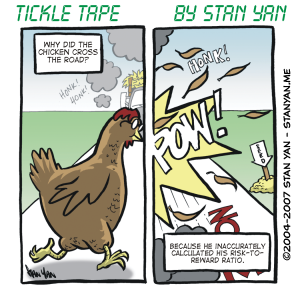Many investment psychology books tout the virtues of thinking independently and acting like a rugged individualist: “Don’t follow the crowd. Be a contrarian.” It’s often useful to take such abstract ideas and make them more concrete with a specific example, even a basic, oversimplified example, as we’ll do today. It’s vital to act as a rugged individualist in today’s markets since there are fewer amateurs trading the markets these days than in the late 1990s. In the “old days,” some investors made nice profits by merely picking a popular stock, waiting for new buyers to enter the markets, and selling when the price hit the profit objective.
Ironically, it was possible to be a conformist and just follow the crowd. When there are many amateur participants, there are strong trends. As prices rise, the media reports on the optimism. Next, the confidence of the masses rises, and more and more enthusiastic buyers enter the markets. In such markets, the uncertain investor can wait for confirmation from positive news or the observation of a sudden buying spree. This conformist strategy works sometimes, but it’s not a strategy that works consistently, or very well today.
These days, you can’t assume that when you “buy low,” there will be an excess of naïve amateur buyers ready to push the price up higher. If you wait too long, you’ll likely hit resistance, and it will be too late to profit from the move. These days, there is less certainty. You must gauge the phase that the market is in, anticipate what will happen next, and enter and exit a trade at optimal times. These conditions require a trader to depend on one’s instincts and rely on one’s perceptions and opinions. Many times one must take a contrary position.
Trading as a contrarian is not merely doing the opposite of the masses. It’s about thinking in reverse. Many traders, in contrast, only look at the obvious. For example, if one goes long on a stock, it’s natural to think that all you have to do is identify a stock that is moving up, buy a few shares, wait for it to go up even more, and sell for a profit. But again, that only works when there are many buyers out there, which is less true today than in the late 1990s. It’s more likely that one will encounter resistance. It’s crucial to anticipate this turning point and make sure that you sell before the price goes down.
That is where thinking in reverse comes in. Instead of following the herd and buying when everyone else is buying, and selling when everyone else is selling, do the reverse. Buy when everyone else is selling, and sell when everyone else is buying. In other words, buy on weakness, and sell on strength. How does this work? Assume that prices move in cycles. For merely illustrative purposes, pretend that market cycles, or waves, go down on Mondays, up on Tuesdays, and down on Wednesdays. If history were to repeat itself, and unfortunately it never does, you could buy low on Monday, wait for Tuesday, and sell at a higher price.
Now if the cycle followed a reliable, consistent pattern, I guess you wouldn’t need to be rugged individualist, a contrarian, or know how to use your intuition. You would know exactly what would happen and when, and trading would be easy. But in the markets “history only repeats itself” when it does; the rest of the time it does not, and no one knows for certain when it will or will not repeat. That’s what makes trading a challenge. One doesn’t know exactly where or when the cycle will repeat. In the end, it’s just a matter of odds. You can’t wait for unswerving confirmation from the herd and merely follow them.
Future prices are not certain, and so that’s where thinking independently like a rugged individualist is relevant. In the final analysis, you only have some fallible trading strategies and your own intuition to rely on. You’ve got to rely on you and no one else, and that’s why it helps if you are a natural, rugged individualist, a person who isn’t used to looking toward others to see what to do next. A rugged individualist is used to taking chances and using gut instincts to make decisions, and that’s all one is doing in the markets: Making a good guess, taking a chance, and patiently waiting to see if it works out. If you want to follow the crowd, wait for a sure thing, or wait for group validation, you are not going to find it in complex markets like the ones we see these days. So nurture your individualist instincts, develop your intuition through experience, and look at the markets from multiple, and often contrary, perspectives.


